 |
|
 
Candle
instructions come with most candles and are usually never read. We ask
that you take
the time to read the below information at least one time.
It offers necessary tips for burning
your candle properly; giving you
the longest burning time so that you get the most enjoyment
from your
purchase. |
|
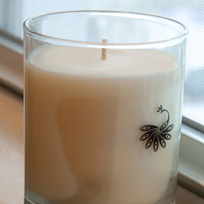 | Wax in a glass as it heats then cools may adhere and release from the glass container in which it is poured. This will create a visual illusion of a bubble in the candle. This does not affect the performance of the candle. It may disappear or reappear if the temperature of the candle’s environment changes. |
|
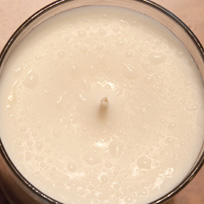 | A humid or warm environment can sometimes cause the fragrance oils to sweat out of the wax. It will appear as beads of liquid on top of the candle. This does not affect the performance of the candle. It may be lit even if “sweating”. If the environment changes they will disappear back into the wax. |
|
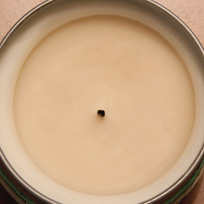 | We choose to keep our wax free of synthetic colored dyes. Since we do not color our wax you may see some natural discoloration at times. Some of our oils will have a natural color to them which will tint the candle wax. The fragrance oils in our candles occasionally react with the wax to create a darker hue to the wax. Heated wax from burning a candle will sometimes darken the wax. This does not affect the performance of the candle. |
|
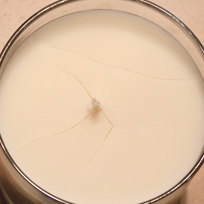 | When a 100% soy candle is exposed to temperatures below 70 degrees, it may develop micro cracks in the wax. The cracks do not affect the performance of the candle and will disappear after the candle is lit. When the candle is warmed back up to 70 degrees and above, the cracks usually disappear. The colder the temperature, the more likely the candle will be subjected to deeper sized cracks. |
|
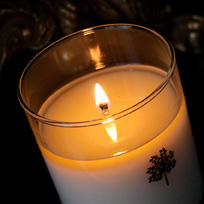 | For
the first use, burn the candle a minimum of one hour
per diameter inch.
This will melt the wax to the edge of
the glass or tin. Our candles are
designed to burn all the
way to the edges. This will allow for maximum
use of the
wax in each candle. |
|
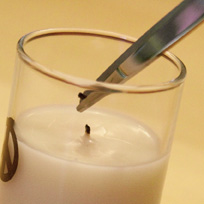
|
Keep the wick trimmed to ¼” before every use. This is
true for any candle. Use a wick trimmer or pinch off the extra wick before lighting.
|
|
 |
If
the flame becomes too low, extinguish it and trim the clogged wick and
re-light. You can also remove some of
the wax around the wick when it
cools making sure you
expose at least ¼” of the wick. Re-light the
candle.
|
|
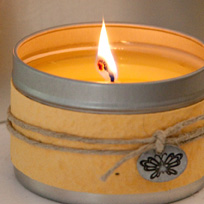
|
If a candle flame becomes too high or if the candle gets too hot, extinguish the flame, trim the wick and re-light the candle.
|
|

|
Keeping a lit candle out of a drafty area is ideal. A draft can create an uneven burn or too hot of a flame.
|
|
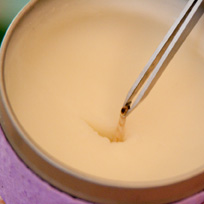
|
A wick that becomes off centered can be corrected by moving it back to the center while the wax is soft but slightly cooled. A centered wick creates the ideal burn, allowing the candle to burn evenly out to all edges.
|
|
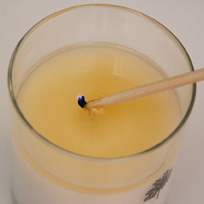
|
You can distinguish a candle’s flame without creating the after smoke. Dip the lit wick in the melted wax and lift back up. You will need a wick dipper or a non flammable object.
|
|
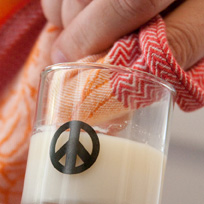
|
After the candle and its wax has cooled, you can wipe the glass on the inside clean from any melted wax residue. This will give you the appearance of a clean new candle.
|
|
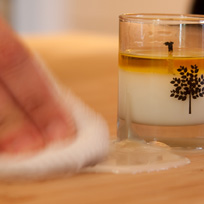
|
Soy wax burns cooler than paraffin wax and therefore is safer if it spills. It can be cleaned up or washed out with warm soapy water. The natural melted soy wax can also be massaged into skin.
|
|
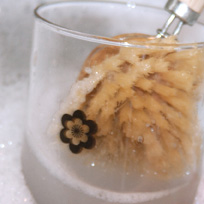
|
After you have completed burning the entire candle or tin, it may be cleaned out for re-use. Wipe out any excess wax residue and compost or discard. Do not pour excess wax down your drain. You may place the candle in a warm oven (150 degrees or lower) to melt the leftover wax for easy removal. Clean out the glass or tin with warm soapy water. The wick can be removed and the metal wick holder can be recycled with other tin items.
|
|
|
It is better to light a single candle then to curse the darkness.
- Chinese Proverb
|
|
